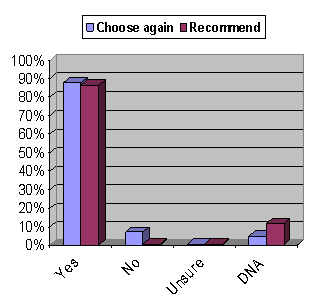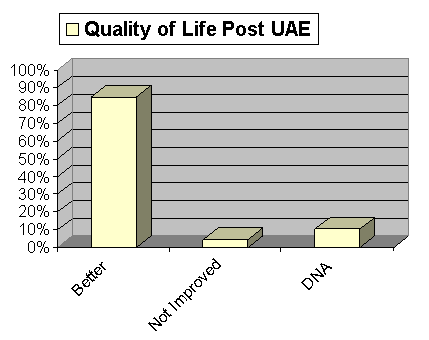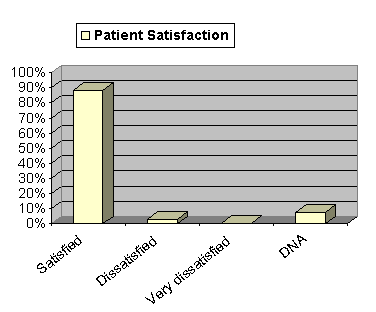Uterine fibroids treatment
The traditional treatment of fibroids over the years has been hysterectomy
Uterine Fibroids treatment and Cure by Fibroid Embolization
Dr. Walker's Series
Dr Woodruff J Walker, Consultant Interventional Radiologist at the Royal Surrey County Hospital and The London Clinic, has so far carried out fibroid embolization (UFE) on over 3,000 patients over 24 years. This has received considerable national coverage (see About Dr Walker, Publications and TV and Newspaper Coverage) In 1996 Dr Walker commenced an ethically approved trial of fibroid embolization at the Royal Surrey County Hospital which later included patients from The London Clinic. The results of the trial have been reported in previous publications.
Mid Term Results
In 2002 we published an analysis of our first 400 patients(9) and a further series in 2002(10). The results of this series indicated a very high success rate of almost 90% with a low incidence of complications i.e. less than 1% incidence of infective complications requiring hysterectomy, a 6% incidence of failure or recurrence, a less than 2% (4 patients) incidence of amenorrhoea (no periods) under the age of 45, and a 6% incidence of troublesome vaginal discharge, usually curable by hysteroscopic procedure(8). Satisfaction rates for the procedure (i.e. where patients stated on follow up that they were satisfied with the procedure and would recommend it), were over 90%. Fibroid shrinkages were over 60%. Interestingly, as techniques improved, since the early series we have had no incidences of infection leading to hysterectomy in over 1,700 cases and the success rates are around 95%.
Patient Satisfaction with UFE
We asked patients whether or not the quality of their lives had changed for the better since UFE, whether they would still choose to have the procedure again and whether or not they would recommend to others and finally we asked for the patient to give an overall level of satisfaction with the procedure.
|
|
Our results showed that over 88% of women would recommend and choose UFE as a form of treatment.
|
|
Over 84% of women reported improvement in Quality of Life post UFE.
|
|
The overall level of satisfaction with the procedure was over 88%.
Long Term Paper Results
In 2006 we published our long term results(2). A total of 258 women were identified as being between 5 and 7 years post UFE and suitable for long-term follow up. 172 completed questionnaires were analysed. 75% of women had either a return to normal or an improvement in menstrual flow compared with how they were prior to UFE. More than 80% of fibroid related symptoms were resolved or improved. 88% of women were satisfied with the outcome of the procedure at 5-7 years and would choose UFE again or recommend it to others. The findings showed that UFE is of benefit to women wishing to avoid hysterectomy and it carries a low risk of complications and its benefit is sustained - more detailed results of long term data below and under Long Term Results paper.
Complications
We have performed fibroid embolization in over 3,000 patients. Since the early phase of the trial our complication rate has fallen and the technique has undergone changes. The two most significant complications of fibroid embolization are premature menopause and infection leading to hysterectomy. We had 5 infections leading to hysterectomy in our first 500+ patients. None of these were acute emergencies or required intensive care unit admission. Since then in over 1,700 patients we have had no hysterectomies due to infection. With regard to amenorrhoea i.e. premature menopause, this has occurred in 5 patients of 773 under 45 years of age i.e. 0.6%. 4 of these, however, again were in our first 400 patients when the technique we were using differed from our current protocol. In addition 2 of the patients had predisposing factors for ovarian failure. Of the 5 patients 4 of them have stated that despite the amenorrhoea they were satisfied with the procedure and would have preferred UFE to hysterectomy. These patients have all done very well. In recent years we have had no ovarian failures in patients under the age of 45 in many hundreds of patients. A small minority of fibroids are expelled spontaneously from the uterus through the vagina and occasionally these fibroids become impacted and have to be removed by putting a small 'telescope' through the cervix into the cavity of the uterus and resecting the fibroids. This almost invariably leads to an excellent result with a virtually normal uterus. In the 1,500 patients, 13 required hysteroscopic resection of impacted fibroids following embolisation.
Current Situation
Since we published our long term paper which looked at patients embolized before 2000 the technique and results have improved and are around 95% with complications markedly reduced as stated above.
References:
1. Walker WJ, Bratby . Magnetic Resonance Imaging (MRI) Analysis of Fibroid Location in Women Achieving Pregnancy After Uterine Artery Embolisation. Cardiovascular interventional Radiology - August 2007.
2. Walker WJ, Barton-Smith P. Long-term follow up of uterine artery embolisation - an effective alternative in the treatment of fibroids. British Journal of Obstetrics and Gynaecology 2006;113:464-468.
3. Walker WJ, McDowell SJ. Pregnancy after uterine artery embolisation for leiomyomata: at series of 56 completed pregnancies. American Journal of Gynecology & Obstetrics November 2006 195(5) 1266-71.
4. Kundu S, Gadani S, Clements R, Asisa J, Wilcock G, Barnwell D Comparison of surgical periprocedural Morbidity/Mortality & Length of Stay with UAE for Symptomatic Uterine Fibroids. Presented SIR Canada 2006.
5. Spies JB, Bruno J, Czyda-Pommersheim F, Magee ST, Ascher S, Jha RC. Long-Term outcome of Uterine Artery Embolisation of Leiomyomata. Obstetrics and Gynaecology 2005;106:933-9.
6. Hanafi M. Predictors of leiomyomas recurrence after myomectomy. Obstetrics and Gynaecology 2005 Apr;105(4):877-81
7. Carpenter T, WJ Walker. Pregnancy following uterine artery embolisation for symptomatic fibroids: a series of 26 completed pregnancies. British Journal of Obstetrics and Gynaecology, 112, pp321-325 March 2005.
8. Walker WJ, Carpenter T, Kent ASH Persistent vaginal discharge after uterine artery embolisation for fibroid tumours: cause of the condition, magnetic resonance imaging appearance, and surgical treatment. American Journal of Obstetrics and Gynecology, Volume 190, Issue 5, May 2004, Pages 1230-1233
9.Walker WJ, Pelage JP. Uterine artery embolisation for symptomatic fibroids. Clinical results in 400 women with imaging follow up. British Journal of Obstetrics and Gynaecology. Nov 2002; 109: 1262-1272
10. Watson GMT, Walker WJ. Uterine Artery Embolisation for the treatment of symptomatic fibroids in 114 women: reduction of size of size of the fibroids and women’s views of the success of the treatment. British Journal of Obstetrics & Gynaecology 2002 Feb;109(2);129-35
11. Walker WJ, Pelage JP, Sutton C. Fibroid embolisation [review]. Clinical Radiology 2002 57(5); 325-31
12. Walker WJ. Bilateral Uterine Artery Embolisation for Fibroids - A Three and a Half Year Experience of over 300 Cases and Comparison with Data from other Centres. The Yearbook of Obstetrics & Gynaecology, Sturdee D, Oláh K, Keans D (Eds) RCOG Press 2001; Vol.9: 209-15
13. Walker WJ. Limitations of Fibroid Embolisation. Controversies in Obstetrics, Gynaecology & Infertility. Ben-Rafael Z, Shohan Z, Frydman R, Monduzzi Editore 2001: 427-33
14. Pelage JP, Le Dref O, Soyer P, et al. Fibroid related menorrhagia: treatment with super selective embolization of the uterine arteries and mid-term follow up. Radiology 2000,215 (2) 428-31
15. Walker WJ. Fibroid Embolisation. Gynaecological Endoscopy. 2000; 9: 343-344
16. Jones K, Walker WJ, Sutton C. Sequestration and Extrusion of Intramural Fibroids following Uterine Artery Embolisation. Gynaecological Endoscopy 2000; 9: 309-13
17. Jones K, Walker WJ. Access Procedures to Treat Menorrhagia in one patient. Gynaecological Endoscopy 2000; 9: 323-5
18.Walker WJ. Bilateral uterine Artery Embolization for Fibroids. Menorrhagia. Sheth C, Sutton C (Eds). Isis Medical Media, Oxford. April 1999: 185-93
19. Goodwin SG, McLucas B, Lee M, et al. Uterine artery embolization for the treatment of uterine leiomyomata: midterm results. Journal of Vascular and Interventional Radiology. 1999; 10: 1159-65
20. Spies JB, Scialli AR, Jha RC, et al. Initial results from uterine fibroid embolization for symptomatic leiomyomata Journal of Vascular and Interventional Radiology. 1999:10: 1149-57
21. Hutchins J FL, Worthington-Kirsch RL, Berkowitz RP. Selective uterine artery embolization as primary treatment for symptomatic leiomyomata uteri. Journal of the American Association of Gynecological Laparoscopists 1999; 6: 279-84
22. Walker W, Green A, Sutton C. Bilateral uterine artery embolisation for myomata: results, complications and failures. Journal of Minimally Invasive Therapy1999; Vol 8 (6): 449-54
23. Walker WJ. Bilateral Uterine Artery Embolization for Fibroids. Menorrhagia. Sheth C, Sutton C (eds). Isis Medical Media, Oxford. April 1999: 185-93
24. Walker WJ. Arterial embolisation in obstetrics and gynaecology with particular reference to uterine fibroids. Advances in Obstetrics and Gynaecology. 1999;16:2-8
25. Worthington-Kirsch RL, Walker WJ, Adler L and Hutchins Jr FL. Anatomic variation in the uterine arteries: a cause of failure of uterine artery embolisation for the management of symptomatic myomata. Journal of Minimally Invasive Therapy, December 1999, Vol 8 (6): 397-402
26. Goodwin SC, (UCLA) USA, Walker WJ (RSCH) UK. Uterine Artery Embolisation for the treatment of fibroids. Current Opinion in Obstetrics and Gynaecology 1998;10: 315-2 5.
27. Takamizawa S, Minakami H, Usui Ret al.Risk of complications and uterine malignancies in women undergoing hysterectomy for presumed benign leiomyomas. Gynecol Obstet Invest 1999; 48: 193-6
28. Dover RW, Sutton CJG, Walker WJ. Arterial embolisation for uterine fibroids. The results of the largest UK series. British Journal of Obstetrics andGynaecology.1998; 105: 52
29. Barr JD, Lemley TJ, Petrochko CN. Polyvinyl Alcohol Foam Particle Sizes and Concentrations Injectable ThroughMicrocatheters.JVIR1998;9:113-118
30. Wallach EE. Myomectomy. In Thompson JD, Rock JA eds. Te Linde's Operative Gynaecology,7th ed, Philadelphia, USA: Lippincott, 1992: 647-62
31. Schuur KH, Bouma J. Palliative embolization in gynaecological patients. Eur J Radiol1983;3(1):9-11
32. Anderson JH, Wallace S, Gianturco C, GersonLP. "Mini" Gianturco stainless steel coils for transcatheter vascular occlusion.Radiology1979, 132 (2):301-3
33. Anderson JH, Wallace S, Gianturco C. Transcatheter intravascular coil occlusion of experimental arteriovenous fistulas AJR Am J Roentgenol1977;129(5):795-8
34. Wingo PA, HuezoCM, Rubin GL, et al. The mortality risk associated with hysterectomy. American Journal of Obstetrics and Gynecology1986; 152:803-8
35. Hill DJ, Complications of hysterectomy. Bellaire’s Clinical Obstetric and Gynaecology 1997;11:181-195
36. Vashisht A, Studd J, Carey A, Burns P. Fatal septicaemia after fibroid embolisation. Lancet July 24 1999; 354:1730
37. Uterine artery embolization survey results: 10, 500 procedures performed world-wide. Society of Cardiovascular and Interventional Radiology, October 1999
38. Mara M, Maskova J, Fucikova Z, Kuzel D, Belsan T, Sosna O. Midterm clinical and first reproductive results of a randomized controlled trial comparing uterine fibroid embolization and myomectomy. Cardiovasc Intervent Radiol 2008;31:73-85
39. Firouznia K, Ghanaati H, Sanaati M, Jalali AH, Shakiba M. Pregnancy after uterine artery fibroid embolisation for symptomatic fibroids: A series of 15 pregnancies. AJR 2009;192:1-5
40. Pisco JM, Duarte M, Bilhim T, Cirurgiano F, Oliveira A. Pregnancy after uterine fibroid embolisation. Fertility & Sterility 2011 Mar 1;95(3)
41. McLucas B. Pregnancy following uterine fibroid embolisation: An update. Minimally invasive Therapy Allied Tecnology 2013 Feb; 22(1)39-44
42. Hirst A, Dutton S, Wu O, Briggs A, Edwards C, Waldenmaier L, Maresh M, Nicholson A, McPherson K. A multi-centre retrospective cohort study comparing the efficacy, safety and cost-effectiveness of hysterectomy and uterine artery embolisation for the treatment of symptomatic uterine fibroids. The HOPEFUL study. Health Technol Assess 2008 Mar;12(5):1-248,iii
43. Hehenkamp WJ, Volkers NA, Donderwinkel PF, de Blok S, Birnie E, Ankum WM, Reekers JA. Uterine artery embolisation versus hysterectomy in the treatment of symptomatic uterine fibroids (EMMY trial): peri- and postprocedural results from a randomised control trial. Am J Obstet Gynecol 2005 Nov;193(5):1618-29
44. The REST Investigators. Uterine-Artery embolisation versus surgery for symptomatic uterine fibroids. N Eng J Med 2007:356:360-370
© Copyright 2015 • All Rights Reserved | Dr. W.J. Walker |


